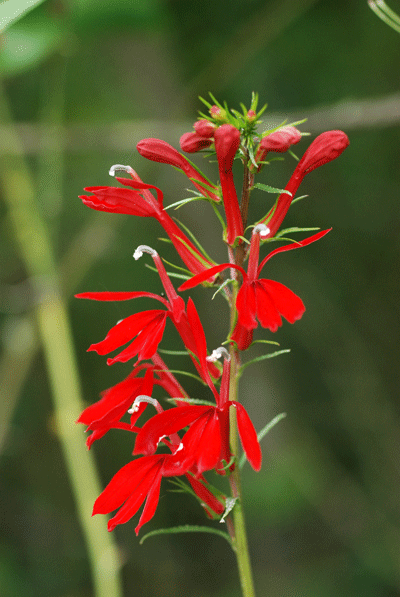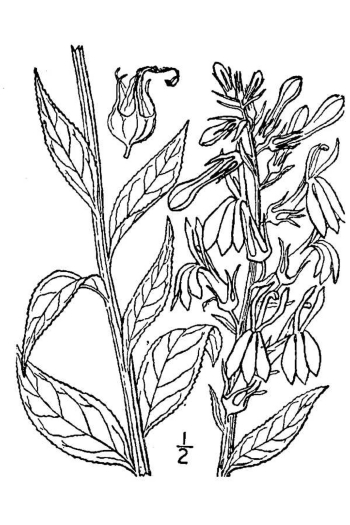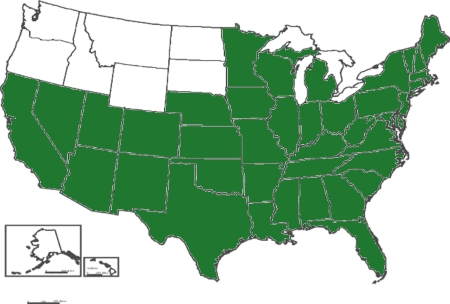Lobelia cardinalis
 |
 |
Photo Jane Morton Galetto |
Britton and Brown |
| Botanical name: | Lobelia cardinalis |
| Common name: | Cardinal flower |
| Group: | dicot |
| Family: | Campanulaceae |
| Growth type: | forb/herb |
| Duration: | perennial |
| Origin: | native |
| Plant height: | 2 - 5' |
| Foliage: | Leaves alternate, thin and glabrous (smooth) |
| Flower: | brilliant vermilion, deep red, 1-1-1/2 inch long, with long stamens projected through a split in the upper lip. |
| Flowering time: | July to September |
| Habitat: | Wet grounds, stream banks |
| Range in New Jersey: | Throughout New Jersey, except in the Pine Barrens, except as an indicator of disturbance. |
| Heritage ranking, if any: | n/a |
| Distribution: |  |
| Misc. | USDA
lists as FACW+. Usually occurs in wetlands (estimated
probability 67%-99%), but occasionally found in non-wetlands. Ethnobotanic: The Iroquois had many medicinal uses for cardinal flower. The root was boiled together with the root of Cichorium intybus and the liquid was used to treat fever sores. The mashed roots, stems, leaves, and blossoms were made into a decoction and drank for cramps. The plant was also used as an emetic for an upset stomach from eating something bad. The plant was added to other medicines to give them more strength. The Delaware used an infusion of the roots to treat typhoid. The Meskwaki used this plant as a ceremonial tobacco, throwing it to the winds to ward off a storm. The Pawnee used the roots and flowers of cardinal flower in the composition of a love charm . Wildlife: Hummingbirds are attracted to the nectar. Deer browsing often damages young plants. Adaptation: Cardinal flower is comparatively easy to grow. The capsules can be collected in autumn, usually October. The stalks are cut below the capsules, and placed upside down in a per sack. Once, home, the bag is opened so that the capsules are exposed to the air for a few days. Shake the bag to release the seeds. Crushing the capsules with a rolling pin and picking out the seeds from the litter can retrieve the capsules that have remaining seeds. The seeds can then be planted right away. Propagation by seeds: The seeds will germinate without cold stratification, but they need light, so sow the seeds in a flat with a damp fine grade peat light mix. Keep the flats moist and under lights or in a greenhouse. They should green up in a few weeks. Transplant them in 4-6 weeks into individual pots. such as 70 cell plug trays, use the same potting mix and keep fertilizing. The seedlings are tiny at first, so fertilize them every other week with a liquid fertilizer. After another 4 weeks they can be put out in the garden or transplanted into larger pots of 4 to 6 inch diameter. Plant the plants in an outdoor spot that is in full sun or very light shade and never dries completely. Space the plants 8 to 12 inches apart. Add plenty of peat moss when planting and mulch well to keep the soil cool and moist. Protect the plants from deer. Cardinal flower will take two years to bloom, forming a large rosette the first year. Allow the plants to self-sow. They are heavy feeders, so compost or a shot of granular fertilizer when they begin growth is recommended. Propagation by cuttings: Take two node stem cuttings (4-6 inches) before the flowers open and remove the lower leaf and half the upper leaf. Treat the cutting with hormodin 2 or roottone and place the cuttings in a sand and perlite medium, cover lightly, water, and remember to keep the medium moist. Roots will form in 2-3 weeks, but the cuttings need to force a good new crown from the lower node to successfully over-winter. Management When well established, clumps of this plant can be divided in the fall or spring by separating the rosettes or basal offshoots from the mother plant and replanting these divisions and watering them immediately. In the winter, keep the leafy offshoots at the base of the drying stems of old plants free of leaf litter to allow them full exposure to the air and sunshine. -Information provided courtesy USDA. |